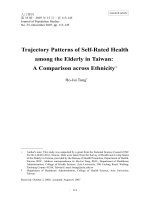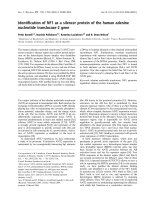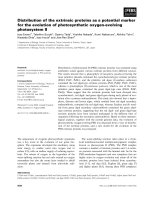Construction of Yeast Pichia pastoris Expressing the Recombinant p53 as a Secreted Protein into Cult
Bạn đang xem bản rút gọn của tài liệu. Xem và tải ngay bản đầy đủ của tài liệu tại đây (1.09 MB, 8 trang )
<span class='text_page_counter'>(1)</span><div class='page_container' data-page=1>
336
<i>Construction of Yeast Pichia pastoris Expressing </i>
the Recombinant p53 as a Secreted Protein into Culture
Tran Thi Thuy Nga
1, Nguyen Quang Hoa
1,
Hoang Van Tuyen
1, Do Thi Tuyen
3, Dinh Nho Thai
1,2,*<i>1</i>
<i>Faculty of Biology, VNU University of Science, 334 Nguyen Trai, Hanoi, Vietnam </i>
<i>2</i>
<i>Key Laboratory of Enzyme and Protein Technology, VNU University of Science, </i>
<i>334 Nguyen Trai, Thanh Xuan, Hanoi, Vietnam </i>
<i>3</i>
<i>Enzyme Biotechnology Laboratory, Institute of Biotechnology, </i>
<i> Vietnam Academy of Science and Technology, 18 Hoang Quoc Viet, Cau Giay, Hanoi, Vietnam </i>
Received 15 July 2016
Revised 25 August 2016; Accepted 09 September 2016
<b>Abstract: Human p53 protein has been known as a tumor suppressor and described as "the </b>
guardian of the genome", referring to its role in conserving stability of genome by preventing
mutation. The recent studies on p53 protein expression have demonstrated the important role and
effectiveness of exogenous p53 protein in tumor suppression. In the world, the expression of p53
for therapeutically interest was extensively study but in Vietnam it has not been noticed. In the
<i>other hand, Pichia pastoris showed a good expression system for many exogenous proteins with a </i>
simple cloning work and cheap culture. In this study, codon optimization of gene encoding human
<i>p53 protein was performed for suitable expression in Pichia pastoris yeast. It was designed as </i>
construct of p53 fused with TAT and His-tag sequences (TAT-p53-His). The construct was cloned
<i>into pPICZαA expression vector by using EcoRI and XbaI enzymes to make </i>
pPICZαA-TAT-p53-His. Yeast strains containing genes coding for TAT-p53-His was obtained. The integration of
TAT-p53-His construct into yeast genome was verified by using PCR with AOX1 primers. The
<i>expression of the recombinant TAT-p53-His in the culture of P. pastoris X33 was confirmed by </i>
SDS-PAGE.
<i>Keywords: Pichia pastoris, gene expression, p53, codon optimization. </i>
<b>1. Introduction</b>∗
<i>Human protein p53, encoded by gene TP53, </i>
contains 393 amino acids with mass about
53kDa [1]. Missense point mutations of p53
protein was found in more than 50% of human
_______
∗
Corresponding author. Tel.: 84-4-38588579
Email:
</div>
<span class='text_page_counter'>(2)</span><div class='page_container' data-page=2>
DNA, p53 is produced with 3 main functions:
controlling of the cell cycle in order to prevent
the cell not to enter cell division phase;
activating the transcription of proteins related to
DNA repair and triggering the cell's apoptosis
program to prevent the abnormal cells [4, 5].
<i>Pichia pastoris</i> is one of the best systems to
the production of heterologous proteins for drug
developments [6-8]. There are several
advantages of this system, such as, the strong
promoter of alcohol oxidase I gene, stably
integrate expression vector into genome, a
simplified purification procedure for secreted
heterologous proteins and post-translational
modifications of foreign proteins [9, 10].
Today, the protein therapy has been
attractively studied and developed as an
important method to treatment of cancer [11].
Recently there are several reports about the
additional foreign p53 into culture causing
inhibition of the growth and inducing apoptosis
of cancer cells [12-14]. With the desire to create
recombinant p53 protein for cancer treatment in
Vietnam, we conduct this study to express an
<i>exogenous p53 in Pichia pastoris yeast. </i>
<b>2. Materials and Methods </b>
<i>2.1. Vector, primers and culture strains </i>
<i>E. coli DH5α and X33 Pichia pastoris yeast </i>
strains were provided by Invitrogen. Vector of
pPICZαA was provided by Enzyme
Biotechnology Laboratory, IBT. Vector
pUC-TAT-p53-His was purchased from IDT
company. Primers used for PCR reactions was
listed in Table 1.
Table 1. Primers used for PCR reactions
STT Primers DNA sequence
1. EcoRI_Fw 5’-ATGATATCGAATTCTACGGTCG-3’
2. XbaI_Rv 5’-TACTCGAGTCTAGAAATCAATGATG-3’
3. AOX1_Fw 3’-GCAAATGGCATTCTGACATCC-5’
4. AOX1_Rv 5’-GACTGGTTCCAATTGACAAGC-3’
</div>
<span class='text_page_counter'>(3)</span><div class='page_container' data-page=3>
<i>2.2. Construction of DNA sequence coding for </i>
<i>Tat-p53-His </i>
The mRNA encoding the protein p53 in
human from NCBI (AB082923.1) was
<i>optimized for suitable expression in P. pastoris </i>
yeast using GenScript Rare Codon Analysis. 33
nucleotides coding for 11 amino acids of TAT
and 18 nucleotides coding for 6X Histidine
were fused with optimized p53 to make
TAT-p53-His sequence. To facilitate the cloning into
expression vector pPICZαA, the recognition
<i>sites of two restriction enzymes EcoRI and XbaI </i>
was designed at the ends of TAT-p53-His
fragment. The whole structure of TAT-p53-His
fragment was artificially synthesized by IDT
company and cloned into pUC-TAT-p53-His
vector. The codon optimized sequences for
TAT-p53-His was presented in Figure 1.
<i>2.3. Construction of PICZαA vector contained </i>
<i>TAT-p53-His sequence </i>
pUC-TAT-p53-His vector was transformed
<i>into competent E. coli DH5α cells by </i>
heat-shock and cultured in LB media contained
ampicillin. pUC-TAT-p53-His plasmid was
<i>extracted by using GenJETTM Plasmid Miniprep </i>
<i>Kit </i> (Fermentas) and TAT-p53-His fragment
was cut by couple of restriction enzymes
<i>EcoRI/XbaI and ligated with T4 DNA ligase </i>
with pPICZαA previously digested with the
same enzymes <i>(EcoRI/XbaI) </i> to make
recombinant pPICZαA-TAT-p53-His plasmid.
This plasmid was transformed into a new
<i>competent E. coli DH5α strains to select the </i>
colonies in LB media contained Zeozin. PCR
technique was used to check the clone of
TAT-p53 with EcoRI_Fw and XbaI_Rv. Further,
<i>TAT-p53-His cloned into pPICZαA was </i>
confirmed by DNA sequencing (First Base,
Singapore).
<i>2.4. Transformation pPICZαA-TAT-p53-His </i>
<i>into yeast and selection of recombinant clones </i>
<i>Pichia pastoris</i> strain (X33) was grown in
100 ml YPD medium (1 % yeast extract, 2 %
peptone, 2 % dextrose) at 30oC, 200 rpm until
OD600 = 1.4-1.6. Cells were collected by
centrifugation at 4.000 rpm, 5 min, 4oC. The
pellet was dissolved in 100 ml ice-cold water
and centrifuged at 4.000 rpm, 5 min, 4oC
(repeated twice). The pellet was washed in 4 ml
ice-cold 1 M sorbitol and re-suspended in 0.2
ml of 1 M sorbitol and the cells were kept on
ice until use. 80 µl above cells were mixed with
5–10 µg of plasmid DNA
<i>(pPICZαA-TAT-p53-His vector previously digested with SacI) by </i>
pulsed electroporation (1500 V, 25 µF, 200Ω).
Immediately after electroporation, 1 ml of
ice-cold 1 M sorbitol was added to the cells and
incubated for 2 h at 30oC and transformants
were selected on YPDS plate contained Zeocin
(1 % yeast extract, 2 % peptone, 2 % dextrose,
1 M sorbitol and 100µg/ml Zeocin). Colonies
appeared after 3 days incubation were used for
colony PCR with AOX1_Fw and AOX1_Rv to
investigate the integration of TAT-p53-His
construct into yeast genome.
<i>2.5. Expression of p53 in Pichia pastoris </i>
<i>X33 yeast </i>
</div>
<span class='text_page_counter'>(4)</span><div class='page_container' data-page=4>
evaluate the possibility of p53 synthesis of
recombinant strains by SDS-PAGE. The
experiments were repeated 3 times and the
growth curve is set based on the average value
and standard deviation of the measurements.
<b>3. Results and Discussion </b>
<i>3.1. Codon optimization for DNA sequence </i>
<i>coding human p53 </i>
Using GenScript Rare Codon Analysis tool,
we analysed the suitable codon indicators CAI
(codon adaptation index) and determined the
codons in the sequences of the gene which are
<i>present as low frequency usage by Pichia </i>
<i>pastoris </i>yeast. The value of 100 is set for the
codon with the highest usage frequency for a
given amino acid in the desired expression
organism. Codons with values lower than 30%
are likely to hamper the expression efficiency
(Fig. 2A).
Figure 2. The distribution of codon usage frequency along the length of the p53 coding sequence for expression
<i>in Pichia pastoris. (A) The p53 coding sequence before codon optimization. (B) The p53 coding sequence after </i>
codon optimization.
In this study, the codons having the
appropriate index under 30% were changed by
the synonymous codons having consistently
with 90-100% (Fig. 2B). CAI index analysis
<i>results of the p53 coding sequence expression </i>
<i>system in P. pastoris yeast showed before the </i>
codon optimization, sequence of gene had CAI
= 0.63, not really suitable for gene expression
in yeast. After being replaced by the
synonymous codons, CAI index increased 0.81
has improved without codons have a low
frequency of use under 30%, instead of the
codon has a high frequency of usage (Fig. 2B).
Nucleotide sequence coding for TAT, p53,
His-tag and restriction enzyme sites were 1247bp,
was named shortly as TAT-p53-His. This
construct was commercially synthesized and
provided as pUC-TAT-p53-His plasmid.
<i>3.2. Construction of the expression vector </i>
<i>pPICZαA-TAT-p53-His </i>
TAT-p53-His was cut and collected back
from pUC-TAT-p53-His plasmid by pairs of
<i>restriction enzymes EcoRI/XbaI (Fig 3A, lane </i>
2). pPICZαA expression vector also was cut to
open the round by this pairs of enzyme (Fig.
3A, lane 4). TAT-p53-His was paired into
<i>vector frame of pPICZαA straight circuit by T4 </i>
DNA ligase and trasformed into the cells of
<i>E. coli </i>DH5α strains. We collected the colony
by PCR technique with specific primer pairs for
vector (AOX1-Fw/AOX1-Rv). Positive
colonies having PCR product of 1.8 kb DNA
band on 1% agarose gel (figure 3B, lane 2-9)
was selected for extraction plasmids and tested
by using restriction enzymes and DNA
sequencing.
</div>
<span class='text_page_counter'>(5)</span><div class='page_container' data-page=5>
Figure 3. Result of electrophoresis of products of restriction enzyme (A) and PCR reactions (B).
<i><b>(A) Processing the pUC-TAT-p53-His and pPICZαA with EcoRI/XbaI; Lane 1: intact pUC-TAT-p53-His; </b></i>
<i>Lane 2: pUC-TAT-p53-His plasmid products digested with EcoRI/XbaI; Lane 3: intact pPICZαA; </i>
<i>Lane 4: pPICZαA products digested with EcoRI/XbaI. Lane M: 1 kb marker. </i>
<b>(B) The PCR products of colonies with the pair of primer AOX1-Fw/AOX1-Rv; Lane 1: negative control; </b>
Lane 2-9: the PCR products of colonies. Lane M: 1 kb marker.
pPICZαA-TAT-p53-Hisplasmid was cut by
<i>enzyme XbaI obtained a DNA band about 4.8 </i>
kb (Fig. 4, lane 2); and when dealing with two
<i>restriction enzymes EcoRI/XbaI, producing a </i>
DNA fragment of 3.6 kb is the vector pPICZαA
and a DNA band about 1.2 kb in size is the
length of TAT-p53-His (Fig. 4, lane 3).
Figure 4. The recombinant vector
<i>pPICZαA-TAT-p53-His was extracted from a colony and checked </i>
by using restriction enzymes. Lane1: intact
pPICZαA-TAT-p53-His vector; Lane 2: product of
<i>digesting pPICZαA-TAT-p53-His with XbaI; </i>
Lane 3: products of digesting
<i>pPICZαA-TAT-p53-His with both EcoRI/XbaI. Lane M: 1 kb marker. </i>
<i>3.3. Construction of P. pastoris X33 strain </i>
<i>contained pPICZαA-TAT-p53-His intergrated </i>
<i>into genome </i>
To insert TAT-p53-His into the yeast’s
genome, pPICZαΑ-TAT-p53-His plasmid was
<i>digested with SacI and transformed into Pichia </i>
<i>pastoris</i> X33 strain. According to the protocol
manual, pPICZαΑ-TAT-p53-His plasmid is
crossedover and inserted the whole exogenous
gene expression structure in AOX1 region in
<i>Pichia</i> genome. Therefore, AOX1 structural
gene in the genome is conserved to produce
alcohol oxidase enzyme to convert methanol as a
source of carbon for yeast growth. This type of
Mut+ strain of recombinants has been preferably
selected because methanol is used as an inducer of
foreign protein biosynthesis and is a carbon
source for recombinant strains to grow well.
The Mut+ recombinants obtained and
verified by using PCR with AOX1 primers.
Results from PCR products electrophoresis of 6
recombinants showed that all of them had two
bands: higher band is AOX1 gene in inherent
Pichia genome (about 2.2 kb) and lower band is
expression structure from recombinant vector
(about 1.8 kb) (Fig. 7, lanes 4-9). Therefore, all
of the recombinants are Mut+ strains.
</div>
<span class='text_page_counter'>(6)</span><div class='page_container' data-page=6>
Figure 5. Electrophoresis result of selection of recombinant strains by using PCR with AOX1 primers.
<i>Lane 1: negative control; Lane 2: PCR product of Pichia genome; Lane 3: PCR product of Pichia transformed </i>
<b>pPICZαΑ; Lane 4 to 10: PCR products of pPICαA-TAT-p53-His recombinant strains. Lane M: marker 1 kb. </b>
<i>3.4. Expression of recombinant TAT-p53-His </i>
<i>protein </i>
<i>P. pastoris</i> X33 strain carrying plasmids
pPICαA-TAT-p53-His and pPICZαA parallel
cultured in YP medium with 1% methanol and
methanol is added per 24 hours. To track the
growth of recombinant strains and the effect of
TAT-p53 to the vitality of the transformants,
we sampled cultures before adding methanol
and measured OD600 culture interval times.
After 72 hours of cultivation, the culture
mediums were collected and used for
SDS-PAGE, Figure 6.
Figure 6. Result of SDS-PAGE with culture media
samples. Lane 1: X33 transformed with pPICZαA
(control); Lane 2: X33 transformed with
pPICZαA-TAT-p53-His; Lane M: protein marker.
In this experiment, TAT-p53-His construct
was secreted in the cultures would have 500
amino acids in size (90 amino acids of α factor
signal sequence + 11 amino acids of TAT
sequence + 393 amino acids of p53 protein + 6x
histidine) and about 65-75 kDa. The control
was absent of this range indicated that we
<i>suscessed in constructing of yeast P. pastoris </i>
expressing the recombinant TAT-p53-His as a
secreted protein into culture. However, there are
several extra-cellular proteins in the culture
media, the steps of expression optimization
and protein purification should be carried out
in the future.
<b>4. Conclusion </b>
In this study, codon optimization of gene
encoding human p53 protein was performed for
<i>suitable expression in P. pastoris yeast. It was </i>
designed as construct of p53 fused with TAT
and His-tag sequences (TAT-p53-His). The
construct was cloned into pPICZαA expression
vector and transformed into yeast strains. The
integration of TAT-p53-His construct into yeast
genome was verified and the expression of the
<i>recombinant TAT-p53-His in the culture of P. </i>
</div>
<span class='text_page_counter'>(7)</span><div class='page_container' data-page=7>
<b>Acknowledgments </b>
This research is funded by the VNU
-University of Science under project number
TN.15.17 to D. N. T. The authors would like to
thank Ms. Vu Thi Bich Ngoc for her technical
assistance.
<b>References </b>
[1] Isobe M., Emanuel B. S., Givol D., Oren M.,
Croce C. M. (1986) Localization of gene for
human p53 tumour antigen to band 17p13. Nature,
320(6057): 84-85.
[2] May P., May E. (1999) Twenty years of p53
research: structural and functional aspects of the
p53 protein. Oncogene, 18: 7621-7636.
[3] Goh A. M., Coffill C. R., Lane D. P. (2011) The
<i>role of mutant p53 in human cancer. J. Pathol., </i>
223(2): 116-26.
[4] Collot-Teixeira S., Bass J., Denis F.,
Ranger-Rogez S. (2004) Human tumor suppressor p53
<i>and DNA viruses. Rev. Med. Virol., 14: 301-319. </i>
[5] Arnold J. L., Morshe O. (2009) The first 30 years
of p53: growing ever more complex. Nature
Reviews Cancer, 9(10): 749-758.
[6] Cereghino J. L., Cregg J. M., (2000) Heterologous
<i>protein expression in the methylotrophic yeast Pichia </i>
<i>pastoris. FEMS Microbiol. Rev., 24: 45-66. </i>
[7] Macauley-Patrick S., Fazenda M. L., McNeil B.,
Harvey L. M. (2005) Heterologous protein
<i>production using the Pichia pastoris expression </i>
<i>system. Yeast, 22: 249-270. </i>
[8] Anumanthan A., Li P., Gao X. G., Ilangovan K.,
Suzara V.V., Düzgüneş N., Renugopalakrishnan
V. (2007) Expression of recombinant proteins in
<i>Pichia pastoris. </i> <i>Appl. Biochem. Biotechnol., </i>
142(2): 105-124.
[9] Cereghino G. P., Cereghino J. L., Ilgen C., Cregg
J. M. (2002) Production of recombinant proteins
<i>in fermenter cultures of the yeast Pichia pastoris. </i>
<i>Curr. Opin. Biotechnol., 13: 329-332. </i>
[10] Bretthauer R. K., Castellino F.J. (1999)
<i>Glycosylation of Pichia pastoris derived proteins. </i>
<i>Biotechnol. Appl. Biochem., 30: 193-200. </i>
[11] Leader B., Baca Q. J., Golan D. E. (2008) Protein
therapeutics: a summary and pharmacological
classification. Nat. Rev. Drug. Discov., 7(1): 21-39.
[12] Ryu J, Lee HJ, Kim KA, Lee JY, Lee KS, Park J,
Choi SY (2004) Intracellular Delivery of p53
Fused to the Basic Domain of HIV-1 Tat. Mol.
Cells, 17(2): 353-359.
[13] Jiang L, Ma Y, Wang J, Tao X, Wei D, (2008)
The transduction of His-TAT-p53 fusion protein
into the human osteogenic sarcoma cell line
(Saos-2) and its influence on cell cycle arrest and
apoptosis. Mol. Biol. Rep., 35(1): 1-8.
[14] Haowei Y., N. Liu, Z. Zhao, X. Zhang, Hao X., B.
Shao and W. Yan (2012), Expression and
purification of human TAT-p53 fusion protein in
</div>
<span class='text_page_counter'>(8)</span><div class='page_container' data-page=8>
<i>Tạo chủng nấm men Pichia pastoris nhằm biểu hiện protein </i>
tái tổ hợp p53 ra môi trường ngoại bào
Trần Thị Thúy Nga
1, Nguyễn Quang Hịa
1,
Hồng Văn Tuyến
1, Đỗ Thị Tun
3, Đinh Nho Thái
1,2<i>1</i>
<i>Khoa Sinh học, Trường Đại học Khoa học Tự nhiên, ĐHQGHN, 334 Nguyễn Trãi, Hà Nội, Việt Nam </i>
<i>2</i>
<i>Phịng Thí nghiệm trọng điểm Cơng nghệ Enzym và Protein, </i>
<i>Trường Đại học Khoa học Tự nhiên, ĐHQGHN, 334 Nguyễn Trãi, Hà Nội, Việt Nam </i>
<i>3</i>
<i>Phịng Cơng nghệ Sinh học Enzyme, Viện Công nghệ Sinh học, Viện Hàn lâm Khoa học và Cơng nghệ </i>
<i>Việt Nam, Số 18 Hồng Quốc Việt, Cầu Giấy, Hà Nội, Việt Nam </i>
<b>Tóm tắt: Protein p53 đã được biết đến với vai trò ức chế khối u và điều chỉnh sự phát triển của tế </b>
bào trong cơ thể người. Các nghiên cứu gần đây về biểu hiện protein p53 trên thế giới đã chứng minh
vai trò quan trọng và hiệu quả của protein p53 ngoại lai trong việc ức chế khối u. Mặc dù biểu hiện
protein p53 trên thế giới đã được nghiên cứu nhiều nhưng ở Việt Nam liệu pháp điều trị ung thư sử
<i>dụng protein p53 chưa được chú ý. Mặt khác, nấm men Pichia pastoris có nhiều lợi thế của hệ thống </i>
biểu hiện của sinh vật nhân thực như cải biến protein, cuộn gấp protein, và biến đổi sau dịch mã, trong
<i>khi vẫn thao tác dễ dàng như ở E. coli hay S. cerevisiae. Trong nghiên cứu này, chúng tôi đã thiết kế </i>
và tối ưu mã bộ ba của đoạn DNA mang trình tự mã hóa protein p53 ở người và các yếu tố cần thiết
cho tinh sạch protein này, gọi là trình tự TAT-p53-His. Trình tự được tổng hợp nhân tạo, tích hợp
trong vector pUC-TAT-p53-His và đã được chúng tôi ghép nối thành công vào vector biểu hiện
<i>pPICZαA ở nấm men Pichia pastoris bằng cách sử dụng đồng thời hai enzyme giới hạn EcoRI và </i>
<i>XbaI tạo thành pPICZαA-TAT-p53-His. Sau khi được biến nạp vào E. coli và kiểm tra đúng trình tự </i>
<i>ADN, vector tái tổ hợp này đã được biến nạp vào nấm men P. pastoris bằng xung điện. PCR với cặp </i>
mồi AOX1 cho thấy trình tự mã hóa TAT-p53-His đã dung hợp vào hệ gen của nấm men. Biểu hiện
của protein tái tổ hợp ra môi trường ngoại bào đã được kiểm chứng bởi điện di SDS-PAGE.
</div>
<!--links-->







